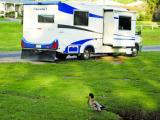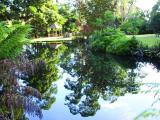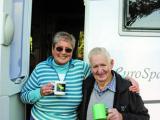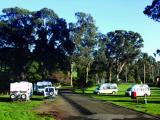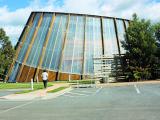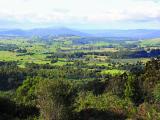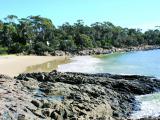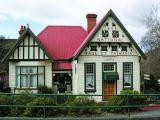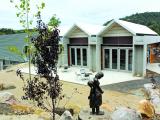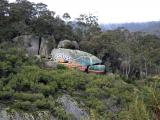Welcome!
7 October 2010
Caravan and motorhome heaven must resemble Northeast Park, Scottsdale
Picture this: a big ‘WELCOME’ sign invites RV-owners to freely camp on the town’s fringe for seven days, in a landscaped park with platypuses in the ponds. Scottsdale (pop. 2000) isn’t viable for a caravan park, but unpowered camping is provided in Northeast Park.
Along the track, grey nomads recommended this hospitable campsite and checks of maps and brochures showed Scottsdale was central to diverse attractions.
A cheery thumbs-up road safety sculpture at Scottsdale’s western entrance was an early indicator of local friendliness. Creation of a ‘people’s park’ in 1930 was the brainchild of Scottsdale man, Charles Northeast, and the park was named after him – not the geographical location. After land was gazetted, citizens’ working bees transformed swampy scrub into parkland. The spring-fed swamp became a trio of stream-linked ponds, home to platypuses and burrowing crayfish (Engaeus). Mud ‘chimneys’ show where crays burrow in the shallows.
Gums, myrtles, melaleucas and manferns were planted and a mini-forest walk was formed. Gardens of flowering bushes, bulbs and small ferns were then created. Service clubs later added toilets, cold showers, barbecue pergolas, walkways and decorative bridges. Not only is the picturesque park equipped with basic facilities and only 1.1km from town, it is a haven for RV owners to leave their vans while they tootle around local features by car or shanks’s pony.
Right on the doorstep, we enjoyed the walkways, fed multi-coloured ducks and glimpsed an echidna. At dusk and dawn, platypuses skimmed across ponds to feed in the shallows. The town has shops, cafes and services ranging from mechanical to medical.
Summer gardens boast rhododendrons propagated from plants brought by immigrants 150 years ago. Historic buildings include the Old Court House, Mechanics Institute, Uniting Church and Beulah Home.
Moving from historic to high-tech, admission-free Forest EcoCentre boasts revolutionary architecture with a building-in-a-building design for year-round insulation and 20% savings on temperature control costs. A translucent outer casing acts as a winter overcoat. As temperatures rise, the casing’s louvers are automatically opened by computerised sensors. Awesome technology!
The building, outfitted in Tasmanian oak, celery pine, myrtle and leatherwood, holds a Forest Interpretation Centre, café and souvenir outlet. Another section has displays about early settlers and Chinese miners.
The EcoCentre also hosts a Visitor Information Centre, where cheerful volunteers selected maps and brochures tailored to our needs.
Attention keen pie-eaters: in town we called in at the highly recommended ‘Cottage Bakery’. Beef and Guinness, curried scallop and chicken and camembert pies ($4.20-$4.70) are among their national award-winning specialties.
A perfect ‘pie picnic’ place was nearby Children’s Reserve, which holds interest for adults. In 2005, a decaying Macrocarpa tree was lopped – but not wasted. The RSL engaged carver Eddie Freeman to turn the stumps into a memorial to World War II and Vietnam veterans.
Images of service personnel, aircraft and weapons were all incorporated. Mr Freeman transformed another stump into ‘Simpson and his donkey’ figures. After happy hour, we joined Northeast Park campers sauntering to town for dinner. Some opted for Scottsdale Hotel-Motel’s hearty meals at budget prices. Others chose Anabel’s fi ne dining, starring Tassie seafood, game and wines. A few chanced recouping their dinner costs on historic Lords Hotel’s pokies. They had loads of fun – and were good losers! Scottsdale is a hub for daytrips in all directions. South 5km on Tasman Highway, then 5km south-east on unsealed South Springfield Road is Springfield Picnic Park – great for walks and wombat spotting.
Tracks meander through Canadian redwood, pines and Douglas fir experimental plantations now preserved for recreational use.
Back on Tasman Highway and 10km further south is a (literally) ‘top of the range’ roadside lookout, ‘The Sideling’. This crest gives sweeping views east over farms and hamlets and to Bass Strait in the distant north. The scenery can be savoured at leisure, since ample parking, toilets, tables and a sheltered wood barbeque are provided. The Sideling tops a road sector treasured by Targa (April) racers for its steep bends.
From Scottsdale, a northern circuit offers diverse attractions. After 5.5km on Bridport Road, we turned west 80m along Oakdene Road to Dorset Museum. Its nostalgia-inducing collections cover yesteryear fashions, furniture, vintage tools and the family Bible of James Scott, surveyor of the town named in his honour. Admission of $6 includes a tour of the stone-walled garden – a riot of rhododendrons, azaleas and camellias in summer.
Bridport, 14km further north, offers ocean sailing, swimming and fishing and is a hot spot for bird-watchers.
In spring, flora fans can indulge their passion for native orchids and wildflowers in a public Wildflower Reserve. A glamorous attraction is Barnbougle Dunes Golf Links. At $60/9 holes, $98/18 holes, it’s not cheap, but keen golfers (are there any other kind?) revere the world-class course. Guests in chalet accommodation have golf at their doorstep.
From golf to grapes: 20km west we turned south to Pipers Brook Vineyard. Rather than pay for tastings in the main building, we visited Jansz Wine Room, 700m away, to freely sample its Chardonnay-Pinot Noir blends. Good Tassie wine and cheeses enjoyed on a terrace… life is good!
At a T-junction further south, we turned east towards Scottsdale. After 12km, a tiny detour north revealed Bridestowe Lavender Farm – the only perfumed lavender source outside Europe. In summer it resembles a fragrant lavender cloud of flowers.
Year-round, it offers lavender-based toiletries and souvenirs. With uncharacteristic self-control we resisted lavender ice-creams, but justified lavender muffins as sustenance while returning to Northeast Park.
Eastern attractions lined our A3 (Tasman Highway) route to the coast. Theoretically Scottsdale is within spitting distance of Derby. We took all day!
Barely 5km from Scottsdale is Cuckoo Falls turn-off. Locals warned us the three to four hour (return) walk is “challenging”, only for fit, hardy hikers and loaded with leeches. We’re easily scared, so we drove on past fields of crops, hops and poppies – the latter grown for medicinal purposes only!
Further east, a carving of a pilot (boasting sporting colours!) indicated Legerwood turnoff. The detour has various benefits: at Legerwood several carvings of local World War I personnel by chainsaw artist Eddie Freeman; at Ringarooma a century-old History and Information Centre and browse-worthy Church Gallery, plus access to Mt Victoria Reserve’s Ralphs Falls.
The unsealed gravel road from Ringarooma up to Ralphs Falls is not recommended for caravans or motorhomes and the 20-minute (return) walk from the carpark to Norm’s Lookout isn’t wheelchair-friendly.
However, the mossy walk and slender falls (longest single drop in Tasmania) are outstanding. Gas barbeques, shelter shed and eco-toilet at the carpark make it an ideal picnic spot.
Back on the A3, we barely got into top before stopping at Branxholm’s red and gold bridge. Panel inscriptions pay tribute to hundreds of Chinese miners who toiled for tin in the 1800s. A local cemetery holds a monument to these pioneers.
A few more clicks and we were relishing a pizza at historic Dorset Hotel in Derby. The Tin Centre is Derby’s newest attraction. It graphically displays local tin mining history, including the 1929 disaster when a dam burst, drowning residents and destroying buildings. However, at $14 per person, the centre is not cheap.
Derby (pop. 175) has a ‘frontier’ ambience, with timber cottages, cafes and craft shops clinging to the valley slopes. It’s usually a quiet place, but not in October, when about 500 competitors and thousands of spectators arrive for the hilarious Derby River Derby. Enthusiastic crews in inflatable craft (mainly homemade) rip 5km downstream in a celebration of mirth and mayhem. Sabotage, rather than speed, is the priority. The aim is to be last afloat – which usually equates to being first to finish.
Fossicking friends had recommended Derby’s Cascade River flats for sapphires, red zircons and topaz, but it was getting too late to start picking and shovelling.
On the east of town we spotted Derby’s whimsical ‘Rainbow trout’ rock, which reminded us of advice about trout fishing. So we soaked bait in Derby River. Wouldn’t have minded striking out, if local anglers hadn’t been landing brown, brook and rainbow trout. However, they were kind enough to tell us we could park overnight in Derby’s riverside park.
So, after another interesting day’s tripping, we happily snuggled into bed, just 41km from hospitable Scottsdale, the heart of north-eastern Tasmania.
TOURIST INFORMATION
For the whole region:
Visitor Information Centre
in EcoForest Centre
96 King St, Scottsdale
(03) 6352 6518
[email protected]
Visitor Information Centre
in EcoForest Centre
96 King St, Scottsdale
(03) 6352 6518
[email protected]
Spirit of Tasmania
Ph: 132010
www.spiritoftasmania.com.au
Ph: 132010
www.spiritoftasmania.com.au
CHEAP TREATS
- Scottsdale’s Dorset Museum
- Scottsdale’s Cottage Bakery gourmet pies
- Ringarooma’s History and Information Centre and Church Gallery
WHEN TO VISIT
Targa Road Race – Late April
Derby River Derby – late October
Bridestowe Lavender Estate – December to January
General touring – November to March
Derby River Derby – late October
Bridestowe Lavender Estate – December to January
General touring – November to March
FREE ATTRACTIONS
- Scottsdale’s Northeast Park wildlife watching
- Scottsdale’s Forest EcoCentre
- Scottsdale’s WWII & Vietnam tree carvings
- Springfield Range’s Sideling Lookout
- Bridport’s Wildflower Reserve
- Pipers Brook free tastings at Janz Wine Room
- Legerwood’s WWI tree carvings
- Mt Victoria Reserve
- Branxholm’s Chinese Bridge and monument
- Derby’s trout fishing and free camping






